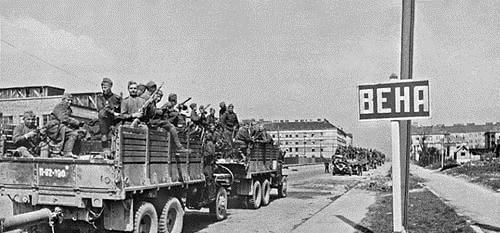Recently, the Russian Satellite News Agency published an article entitled "The Red Army of the Soviet Union Liberated the Austrian Capital in World War II", in which it was written that seventy-five years ago, on April 13, 1945, a strategic direction, a city turned into a fortress, Soviet soldiers gave their lives for the Austrians, and the battle against Vienna is considered by historians to be the most "beautiful" (classic) battle in World War II.
The article describes the process of the Red Army's liberation of Vienna, the capital of Austria, from three aspects: strategic objectives, the road to Berlin, and an orderly offensive.

The first is the strategic goal, from the perspective of Germany in World War II, because Austria had a large amount of oil and military industry at that time, so it was a strategically important industrial center. At the same time, it is interesting that Austria itself was Hitler's birthplace, so in general, not only did the German high command attach great importance to Austria in World War II, but even Hitler demanded that the German army hold its capital Vienna even if it was the last man.
From a Soviet point of view, as long as they could take Vienna, Austria, the Soviet army could completely open the road to Prague and Berlin.
In summary, it is precisely because Austria was a very important strategic place in the eyes of the Soviet Union and Germany at that time, so the German army even mobilized all the men aged 16 to 60 in the city to join the Militia of the Third Reich in order to defend Vienna. At the same time, on the basis of equipping them with light weapons, they were also specially provided with anti-tank rockets for the recruits to deal with Soviet tank armored vehicles.
The second was the road to Berlin, where in March 1945 the 3rd Ukrainian Front, commanded by Marshal Fyodor Tolbukhin, launched an offensive into the Lake Balaton region, armed with 200 tanks and self-propelled artillery.
Soon after the battle began, the 3rd Ukrainian Front quickly surrounded and defeated the 6th SS Panzer Corps. Throughout the advance, the Soviet army, although blocked by the Germans, entered Austria on 30 March and reached the outskirts of Vienna around 5 April to fight fiercely.
At the same time, the Supreme Commander of the Soviet Union also issued a decisive battle order, requiring the Soviet army to capture Vienna on April 13 and 15 at the latest. Immediately afterwards, the Soviets gathered 640,000 officers and men, 1,300 tanks and about 1,000 aircraft to launch a general offensive on the Austrian capital from three directions.
In addition, the Germans not only laid several lines of defense on the outskirts of Vienna, with many bunkers, bunkers, barbed wire and minefields, but also blew up almost all bridges across the Danube, leaving only the Imperial Bridge (which the Germans relied on to mobilize their forces). So far, the Germans had assembled 430,000 troops, 6,000 cannons, 700 tanks and an equal number of aircraft in Vienna and the surrounding area.
Finally, the orderly offensive, in the battle against Vienna, the Soviet army made extensive use of the combat experience of Stalingrad and Budapest and other cities, and occupied one region after another in an orderly and planned manner.
This was also a feature of the campaign, namely that although the Soviets had deployed a large amount of heavy equipment, in order to avoid destroying the city, the soldiers in most cases relied on the light weapons in their hands to eliminate the Germans. On 13 April, when the Red Army occupied all of Vienna, the city was ultimately not badly damaged.
The Germans suffered 130,000 casualties and were captured, and the Red Army lost 40,000 officers and men. Although many Austrians swore allegiance to Hitler before the battle began, when the Soviets liberated Vienna, the local residents still sent flowers and music to the soldiers!